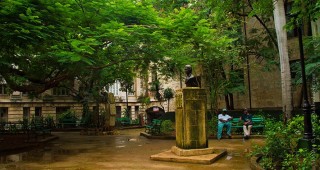Factoría Habana is an experimental center for present-day artistic creation. The institution, which is ascribed to the City Historian’s Office, seeks to become a bridge between Latin American and European art.
Factoría Habana is an experimental center for present-day artistic creation. The institution, which is ascribed to the City Historian’s Office, seeks to become a bridge between Latin American and European art.

 3
3Recently restored, El Torreón or as locals call it Castillito (literally, small castle), built in 1649 with blocks from the San Lázaro Quarry (where José Martí was sentenced to forced labor), was part …

 4-
4-The grandiose palace overlooking the broad cobbled plazuela to the southeast side of Plaza de Armas is the deluxe Hotel Santa Isabel, with its entrance at the corner of Baratillo and Obispo. The hotel …
 Scenic view/caféBaratillo 9, entre Obispo y Narciso López, Habana Vieja
Scenic view/caféBaratillo 9, entre Obispo y Narciso López, Habana Vieja 
 3
3One of the busiest streets in Old Havana, second only to Obispo, Mercaderes runs north-south parallel to and two blocks inland of Avenida del Puerto, linking Plaza de la Catedral with Plaza Vieja. The …

 3
3Built in 1959, this is the oldest and only orthodox synagogue in Cuba. The building has a room for praying that can seat 600 people, a mikve and a hall. Opening hours: Shajarith: 8am (daily except on …

 3
3After the city walls began to be demolished in 1863, construction works for a luxury hotel began on El Prado Avenue, one of the city’s most popular promenades. Manuel López and Urbano González, owners …
 OtherAdmission: NoneTrocadero 55, entre Prado y Zulueta
OtherAdmission: NoneTrocadero 55, entre Prado y Zulueta 
 3
3This ethnographic museum dedicated to Islamic cultures founded in1983 displays modest exhibitions on Islamic textiles, carpets, clothing, weapons, ceramics and furniture. The museum is housed in two e …

 3
3Valued in approx 50 million dollars, the museum’s collections features medals, coins and banknotes from around the world, including an early 20 peso coin, the only one still existing of the ten produc …
 ModernAdmission: CUC 1Open: 9am-5pm Tues-SunObispo at 305, e/ Aguiar y Habana, Habana Vieja
ModernAdmission: CUC 1Open: 9am-5pm Tues-SunObispo at 305, e/ Aguiar y Habana, Habana Vieja 
 3
3In this 19th-century house, the scientist Alejandro de Humboldt installed his instruments and botany and mineral collections while ensconced here 1800-1801. Restored as a museum in 1997, the five exhi …

 3
3This 1920s eclectic hotel is best known for being described by Hemingway as “a good place to write.” He stayed here during the 1930s and this is where he wrote his chronicles on fishing and the first …
 EclecticAdmission: FreeObispo #153, esq. a Mercaderes, Habana Vieja
EclecticAdmission: FreeObispo #153, esq. a Mercaderes, Habana Vieja 
 3
3Although modified by later reconstructions, this Art Nouveau apartment building has preserved its beautiful wooden door carved with floral motifs and flanked on both sides by two slender stone pelican …